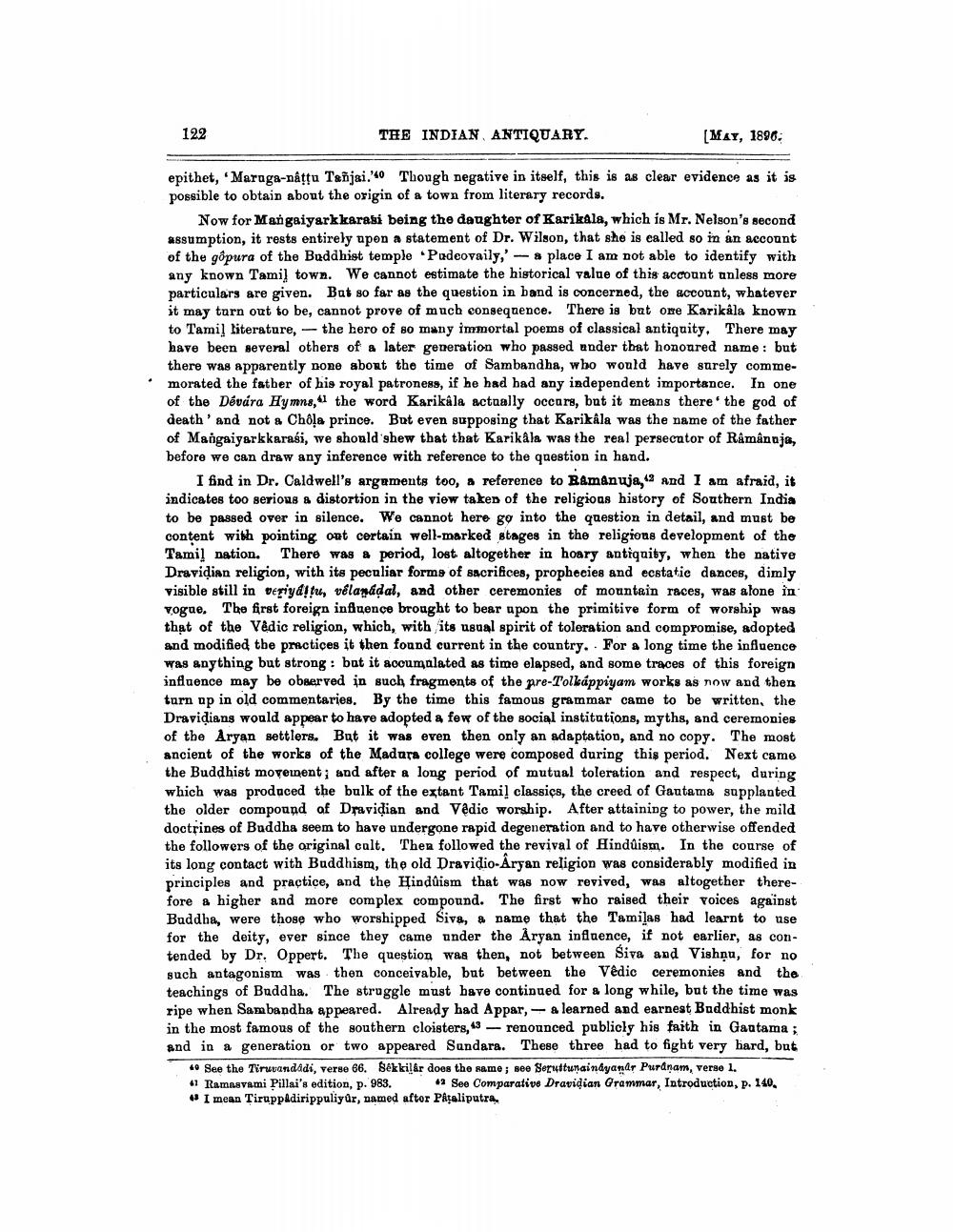________________
122
THE INDIAN ANTIQUARY.
MAY, 1890.
epithet, Maruga-nattu Tanjai. Though negative in itself, this is as clear evidence as it is possible to obtain about the origin of a town from literary records.
Now for Mangaiyarkkarasi being the daughter of Karikala, which is Mr. Nelson's second assumption, it rests entirely upon a statement of Dr. Wilson, that she is called so in an account of the gopura of the Buddhist temple Padeovaily,' - 8 place I am not able to identify with any known Tami) town. We cannot estimate the historical value of this account unless more particulars are given. But so far as the question in band is concerned, the account, whatever it may turn out to be, cannot prove of much consequence. There is but ore Karikåla known to Tamil literature, - the hero of so many immortal poems of classical antiquity. There may have been several others of a later generation who passed under that honoured name: but there was apparently none about the time of Sambandha, who would have surely commemorated the father of his royal patroness, if he had had any independent importance. In one of the Dévára Hymns," the word Karikala actually occurs, but it means there the god of death' and not & Chola prince. But even suppoging that Karikala was the name of the father of Mangaiyarkkarasi, we should shew that that Karikala was the real persecutor of Râmânaja, before we can draw any inference with reference to the question in hand.
I find in Dr. Caldwell's arguments too, a reference to Ramanuja, and I am afraid, it indicates too serious & distortion in the view taken of the religious history of Southern India to be passed over in silence. We cannot here go into the question in detail, and must be content with pointing out certain well-marked stages in the religions development of the Tamil nation. There was a period, lost altogether in hoary antiquity, when the native Dravidian religion, with its peculiar forms of sacrifices, prophecies and ecstatic dances, dimly visible still in deriyditu, vēlamadal, and other ceremonies of mountain races, was alone in vogae. The first foreign influence brought to bear upon the primitive form of worship was that of the Vedic religion, which, with its usual spirit of toloration and compromise, adopted and modified the practices it then found current in the country. For a long time the influence was anything but strong: but it accumulated as time elapsed, and some traces of this foreign influence may be observed in such fragments of the pre-Tolkáppiyam works as now and then turn up in old commentaries. By the time this famous grammar came to be written, the Dravidians would appear to have adopted a few of the social institutions, myths, and ceremonies of the Aryan settlers. But it was even then only an adaptation, and no copy. The most ancient of the works of the Madura college were composed during this period. Next came the Buddhist moveinent; and after a long period of mutual toleration and respect, during which was produced the bulk of the extant Tamil classics, the creed of Gautama supplanted the older compound of Dravidian and Vedic worship. After attaining to power, the mild doctrines of Buddha seem to have undergone rapid degeneration and to have otherwise offended the followers of the original calt. Then followed the revival of Hinduism. In the course of its long contact with Buddhism, the old Dravidio-Aryan religion was considerably modified in principles and practice, and the Hinduism that was now revived, was altogether therefore a higher and more complex compound. The first who raised their voices against Buddha, were those who worshipped Siva, a name that the Tamilas had learnt to use for the deity, ever since they came under the Aryan influence, if not earlier, as contended by Dr. Oppert. The question was then, not between Siva and Vishnu, for no such antagonism was then conceivable, but between the Vedic ceremonies and the teachings of Buddha. The struggle must have continued for a long while, but the time was ripe when Sambandha appeared. Already had Appar, - & learned and earnest Buddhist monk in the most famous of the southern cloisters, 13 - renounced publicly his faith in Gautama; and in a generation or two appeared Sandara. These three had to fight very hard, but
*See the Tiruvandadi, verse 66. Békkilar does the same; see Seruettunainayandr Puranam, verso 1. 41 Ramsavami Pillai's edition, p. 983.
See Comparative Dravidian Grammar, Introduction, p. 140. I mean Tirupp&dirippuliyur, named aftor Påtaliputra,




